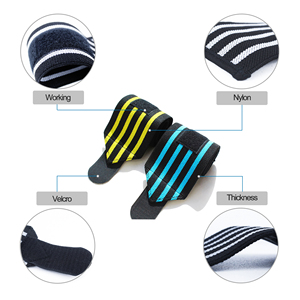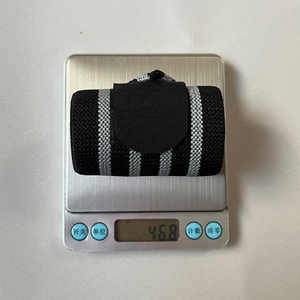(35901 products available)













































































































































































A bracing strap is a metal strap used in construction to support or connect two parts. It is an L-shaped strap with a hole in each end for screws or bolts. Sometimes, it may be straight or have a zigzag or triangular pattern to provide more support. They are usually made of galvanized steel, but they can also be made of aluminum or iron. The bracing strap supports various structures, such as wooden frames, metal frames, roofs, shelves, and furniture.
Bracing straps are classified based on their application, such as:
Corner brace straps: These straps support right-angle corners. They are placed on the outside corners of frames or furniture to provide more stability. The straps resist any forces trying to twist the corners. They are L-shaped, with one strap longer than the other. The longer strap is nailed or screwed into the vertical or horizontal surface, while the shorter strap is fixed to the horizontal surface.
Framing straps: Also known as framing or bridging strapping, they are thin metal straps with multiple holes along their length. They are used to connect and reinforce wooden or metal framing members. The straps are typically installed diagonally between joists, rafters, or studs. They help distribute loads evenly and prevent the framing members from warping or sagging. They are beneficial in attic and ceiling framing.
Web strapping: These are heavy-duty bracing straps used to improve the structural integrity of beams and trusses. They are made from high-gauge steel and are installed diagonally across the web of a truss or the bottom of a beam. They help transfer loads and tensile forces efficiently, providing additional support to wooden structures. They are especially useful in load-bearing walls.
Flat straps: These are versatile bracing straps. They are straight straps with holes along their length and are used to connect and reinforce flat surfaces. They can be used on exposed and hidden applications. They are made from galvanized steel to prevent rusting. They are used to reinforce shelves, cabinets, and furniture or connect metal framing in construction.
Bracing straps have a primary function, which is to brace or support the connection between two materials. They provide stability and reinforcement to the structure. The features listed below make bracing straps suitable for their primary function.
Material
Bracing straps are made of different materials, including mild steel, galvanized steel, aluminum, brass, and high-carbon steel. Some bracing straps are made with composite material. The bracing strap material is usually chosen based on the required strength. For example, if the bracing strap will be used to support a heavy load or structure, it will be made with a strong and durable material. The choice of material will also consider the environmental condition. Bracing straps made with galvanized steel or stainless steel will be used in areas exposed to water or moisture to prevent corrosion.
Thickness
The thickness of a bracing strap will affect its strength and load-carrying capacity. A thicker bracing strap will support more weight than a thinner bracing strap. Some manufacturers allow customers to choose the thickness of the bracing strap according to their needs.
Size and length
Bracing straps come in different sizes and lengths. The size and length will determine the application area and use. For example, larger sizes and lengths of bracing straps will be used for big structures, while smaller sizes and lengths will be used for smaller structures.
Design and configuration
The design of a bracing strap will influence how loads and forces are distributed across the strap. The configuration details, such as holes and notches, will allow for easy installation and adjustments.
Load capacity
This feature indicates the amount of load the bracing strap can support. This load will be evenly distributed across the strap. The load capacity is determined by the material, thickness, and environmental factors.
Bracing straps are essential in construction and other industries. They provide extra support and stabilization to structures. Here are some common usage scenarios for bracing straps:
Bracing Straps for Timber Frame Construction:
Bracing straps are used for timber frame construction. They are fixed to the exterior wall and interior walls. The straps transfer loads from the walls to the foundation. It helps to keep the building frame stable and rigid. Bracing straps prevent the building frame from twisting, especially during strong winds.
Bracing Straps for Roof Structures:
Bracing straps are used to support and stabilize roof structures. They are connected to roof trusses and rafters. The straps distribute loads to the walls. It prevents the roof from sagging or collapsing. Bracing straps are essential for houses and large structures like stadiums and warehouses.
Bracing Straps for Wooden and Metal Sheds:
Bracing straps are used to stabilize and strengthen wooden or metal sheds. The straps are usually placed diagonally across the walls. They prevent the walls from leaning or swaying. Bracing straps are easy to install and provide extra support to sheds in windy areas.
Bracing Straps for Greenhouses:
Bracing straps provide stability to greenhouses. They are fixed to the frame of the greenhouse. The straps prevent the frame from swaying or leaning due to wind or tension. Bracing straps are vital for large greenhouses. They help to maintain the structural integrity of the greenhouse and ensure its longevity.
Bracing Straps for Gates and Doors:
Bracing straps are used on gates and doors. They are placed diagonally across the frame of the gate or door. The straps prevent the gates or doors from sagging. They also prevent warping. Bracing straps ensure that gates and doors function properly and remain aesthetically pleasing.
Bracing Straps for Corners:
Bracing straps are used at the corners of buildings. They are connected to the top plates and bottom plates. The straps form a tension connection between the elements. They help to distribute loads and increase the structural integrity of the building. Bracing straps prevent corners from collapsing or failing.
The following are some important considerations for choosing the right bracing strap:
Load Capacity
Each strap's load capacity must be evaluated to ensure it can support the intended load. This is especially important for heavy-duty applications in construction projects. Consider carrying out load calculations to determine the appropriate strap type and size. Consult the manufacturer's guidelines to choose a strap with a load capacity greater than the estimated load.
Materials
The bracing strap material greatly influences its strength, durability, and resistance to environmental factors. Straps can be made of various materials, such as galvanized steel, stainless steel, and high-strength nylon or polyester. Steel straps are known for their strength and load-carrying capacity. They can be galvanized or powder-coated for rust resistance. Consider the environmental conditions where the strap will be used. Coastal areas or high-moisture environments may require stainless steel due to its superior corrosion resistance.
Size and Dimensions
Buyers should ensure that the strapping dimensions are appropriate for their construction needs. This includes considering the width, thickness, and length of the strap. A wider strap distributes the load better and provides more stability. A wider strap also offers better support for structural members. A strap's increased thickness usually means it has increased strength. Consider the available space and structural elements when selecting the strap's length. Ensure the length is adequate to cover the required application. Remember that shorter straps may not provide adequate support, while longer ones may be unnecessary and waste material.
Ease of Installation
Factors that affect ease of installation should be considered when choosing a bracing strap. For instance, look for straps with pre-punched holes for easy fastening. Also, consider straps that come with installation accessories, such as screws and rivets. Additionally, elements like strap flexibility and the need for special tools can greatly affect the installation process.
Q: What's the difference between a bracing strap and a tie down strap?
A: Bracing straps and tie-down straps are both load straps used to secure items. However, the items have different applications. For instance, tie-down straps are used to secure cargo in transit, while bracing straps provide structural support to framework.
Q: What weight can a bracing strap hold?
A: The weight capacity of the bracing strap depends on the size and type. For instance, a 1-1/4 inch x 14 foot strap can support a load of 1,200 pounds, while a 2-inch x 10-foot strap can support a load of 1,500 pounds. Generally, these straps have a high tensile strength and load capacity.
Q: How to maintain and store bracing straps?
A: To ensure longevity, the bracing straps should be stored and maintained properly. They should be kept in a dry place to avoid rot or rust. Users should also inspect the straps regularly for any signs of damage and cut up any damaged straps. Avoid exposing the bracing straps to sharp objects or excessive heat.
Q: Are bracing straps easy to install?
A: Yes, the bracing straps are easy to install. They come with holes or eyelets that facilitate quick and easy installation. Users can use nails, screws, or rivets to install the bracing straps. The bracing straps also have adjustable tensioning features for easy installation.